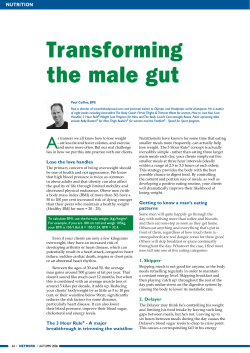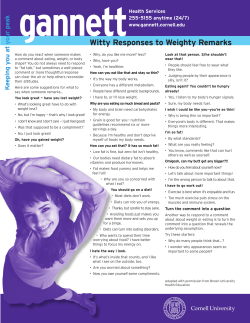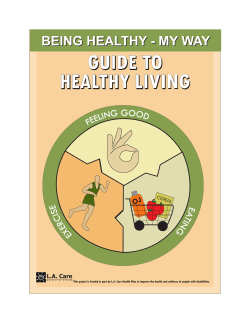
WIN Getting on Track Physical Activity and Healthy Eating for Men
WIN Weight-control Information Network Getting on Track Physical Activity and Healthy Eating for Men Getting on Track Physical Activity and Healthy Eating for Men INTRODUCTION Take a minute to think about your weight, health, and lifestyle. Are you as fit and healthy as you would like to be? Do you think you might be carrying a little too much weight or body fat? You can get on track with regular physical activity and healthy eating habits. By making small changes to your lifestyle, you may become leaner and more energetic. Keep reading for tips on how to get on track with healthy habits— chances are, you will find that it is not as hard as you thought. 1 WHAT IS A HEALTHY WEIGHT? Body mass index (BMI) is a tool that is often used to determine if a person is a healthy weight, overweight, or obese, and whether a person’s health is at risk due to his or her weight. BMI is a ratio of your weight to your height. You can refer to the chart on the next page to find your BMI and see what a healthy weight range is for your height. A BMI of 18.5 to 24.9 is considered healthy. A person with a BMI of 25 to 29.9 is considered overweight, and a person with a BMI of 30 or more is considered obese. Another way to determine if your health is at risk because of your weight is to measure your waist. Waist measurement does not tell if you are overweight, but it does show if you have excess fat in your stomach. You should know that extra fat around your waist may raise your health risks even more than fat elsewhere on your body. Also, men are more likely than women to carry their extra weight around their stomach. Men whose waists measure more than 40 inches may be at an increased risk for diabetes, high blood pressure, stroke, and other problems. A downside of using BMI is that it does not take into account whether body weight is due to muscle or fat. Therefore, someone who is very muscular may be thought to have excess fat, even if he has low or normal body fat. For the vast majority of Americans, though, BMI is a good way to tell if you have increased health risks due to your weight. • • • 2 TABLE 1: BODY MASS INDEX WHY DO WEIGHT AND LIFESTYLE MATTER? Being overweight, obese, or physically inactive may increase your risk for: •• coronary heart disease •• type 2 diabetes •• high blood pressure •• stroke •• some types of cancer, including colorectal and kidney cancer On the other hand, being active, eating healthier, and achieving and staying at a healthy weight may help: •• Improve mood and energy levels. •• Increase fitness and strength. •• Improve muscles. 3 GETTING FIT Pick an activity that you enjoy and will do. This activity should get your heart and breathing rates up, but is not so tiring that you cannot talk while doing it. TYPES OF PHYSICAL ACTIVITY Moderate Intensity •• brisk walking •• weight training •• recreational swimming Vigorous Intensity •• jogging •• fast-paced sports, like football Visit the “ChooseMyPlate” website from the U.S. Department of Agriculture for information on healthy eating and physical activity at http://www.choosemyplate.gov. • • • 4 TIPS FOR GETTING FIT •• Start with a level of activity that feels doable and gradually increase the frequency, time, and intensity of your exercise. You might begin with 10 minutes of daily activity for the first week, for example, and then increase your time to 15 minutes a day the next week. •• Work up to an amount of activity that allows you to reach your goal. It may be 45 minutes a day or it may be 90 minutes a day. •• Activities like chores, walking up stairs, and playing outside with the kids count too. •• Remember, you do not have to do 30 minutes of exercise all at once to be healthy. Instead, you can take three 10-minute walks throughout the day. EXERCISE YOUR OPTIONS To get on track and stay on track, you should try different types of exercises and activities. The chart below lists several types of physical activity, provides examples of each, and describes how each activity is good for you. ACTIVITY Aerobic Exercise EXAMPLES Walking, jogging, swimming, biking POTENTIAL BENEFITS Improves fitness, burns calories, aids in weight loss, improves mental well-being Strength Training Weight machines, free weights, crunches, push-ups Improves strength, increases muscle size, burns calories, aids in weight loss Flexibility/ Stretching Traditional stretching, yoga, Tai Chi Reduces injury risk, improves blood flow, helps recovery from muscle soreness Sports Basketball, racquetball, tennis, golf (if you walk the course) Improves fitness, strength, and coordination; burns calories; adds variety Lifestyle Activities Washing the car, taking the stairs, mowing the lawn Burns some calories and reduces health risks Most men can safely increase their physical activity without consulting a health care professional, but men over age 40 and those with a history of coronary heart disease or diabetes should speak with a health care professional before starting a vigorous exercise program. A HEALTHY EATING PLAN = A VARIETY OF FOODS •• •• •• •• •• whole grains vegetables fruits lean meats and seafood low-fat or fat-free milk products 5 EATING SMART •• Eating smart may improve your health and your waistline. •• You can also improve your eating habits by adjusting portion sizes and still enjoy delicious foods and an occasional treat. EASY TIPS FOR EATING SMART •• Sneak in fruits and vegetables. Add berries to your cereal or crunchy vegetables to your sandwich. •• Be aware of what you drink as well as what you eat. Sodas, sports drinks, and juices may be high in caffeine or calories, especially from sugar. •• Do not overdo it with alcohol. Alcohol can be a major source of hidden calories. A single shot of liquor, about 2 ounces, has about 125 calories. A 5-ounce glass of wine or a 12-ounce glass of beer has 160 calories. KEEPING PORTIONS UNDER CONTROL In addition to what you eat, how much you eat also affects your weight. The pictures on the next page give you an idea of what portion sizes look like for some foods. Try to “eyeball” your portion sizes using everyday objects—it may help you control how many calories you consume. Pay attention to the serving sizes listed on Nutrition Facts labels. For example, the label on a loaf of bread may list nutritional information for one slice. But if you eat two slices in a sandwich, you have eaten double the calories, fat, and other nutrients. • • • 6 Serving Sizes = Everyday Objects 1 cup of cereal = a fist 1/2 cup of cooked rice, pasta, or potato = 1/2 baseball 1 baked potato = a fist 1 medium fruit = a baseball 1/2 cup of fresh fruit = 1/2 baseball 1 1/2 ounces of low-fat or fat-free cheese = 4 stacked dice 1/2 cup of ice cream = 1/2 baseball 2 tablespoons of peanut butter = a ping-pong ball Eating slowly or eating from a smaller plate may help you control how much you eat. Before you reach for a second helping, stop and ask yourself if you are still truly hungry. When you eat out, try splitting a meal or dessert with a friend or significant other, or taking half of your meal home in a take-out container. You may save big on calories, and it is tough to beat two meals for the price of one. 7 ACHIEVING YOUR GOALS Set the Course Focus on what you want to achieve in the shortterm and over the long run. An example of a shortterm goal might be to replace soda with water for a week. A good long-term goal might be to walk or run at least three times a week in preparation for an upcoming charity walk or fun run. Expect Roadblocks Everyone runs into roadblocks sometimes, so expect them, think of ways to overcome them, and get back on your feet if they set you back. Common roadblocks include: •• loss of motivation •• lack of time •• an upcoming vacation To manage or overcome a setback: •• Find a workout partner to boost your motivation. •• Try exercising at lunch if you are short on time in the evening. Chart Your Progress To track your efforts, simply jot down your physical activity or healthy eating choices for the day in a small notebook. Several websites also offer online physical activity and nutrition trackers for this purpose. See the “Additional Resources” section at the end of the brochure for more information about these websites. Goals should be realistic and specific, so set yours carefully. Running a marathon is likely not the best goal for someone just starting to get in shape. Similarly, a goal such as “eating healthier” may not be helpful because it is too vague. • • • 8 Stay Motivated Setting goals may boost your motivation to eat smart and stay active. But you may need more sources of inspiration—so set rewards along with your goals. Examples might be new workout clothing after you complete a week of regular workouts, or buying a new CD when you lose 5 pounds. Finally, try asking friends or family members to join you in eating healthier and being more active. Healthy choices become easier when everyone is working toward similar goals. THE BIG PICTURE Being more active and eating better are two of the best ways you can take care of yourself. Other ways to improve your physical and mental health include: •• Getting adequate sleep. •• Quitting smoking. •• Reducing alcohol intake. By rewarding yourself with a fit and healthy lifestyle, you are taking control of your future and setting an example that your family and friends can follow. That is really something to take pride in. H Clinical trials are research studies involving people. Clinical trials look at safe and effective new ways to prevent, detect, or treat disease. Researchers also use clinical trials to look at other aspects of care, such as improving the quality of life for people with chronic illnesses. To learn more about clinical trials, why they matter, and how to participate, visit the NIH Clinical Research Trials and You website at http://www.nih.gov/health/ clinicaltrials. For information about current studies, visit http://www.ClinicalTrials.gov. 9 ADDITIONAL READING FROM THE WEIGHT-CONTROL INFORMATION NETWORK Just Enough for You: About Food Portions • 2012 Tips to Help You Get Active • 2013 ADDITIONAL RESOURCES American Heart Association Just Move This website features a free online physical activity tracker. Internet: http://www.justmove.org Centers for Disease Control and Prevention Health Information for Men These web pages offer information on a variety of men’s health topics. Internet: http://www.cdc.gov/men Phone: 1–800–311–3435 National Diabetes Education Program Diabetes and Obesity Information The National Diabetes Education Program provides information and offers a recipe and meal planner guide. Internet: http://www.yourdiabetesinfo.org Phone: 1–888–693–NDEP (1–888–693–6337) National Heart, Lung, and Blood Institute Aim for a Healthy Weight This website includes a “Portion Distortion” quiz and BMI assessment tool. Internet: http://www.nhlbi.nih.gov/health/public/heart/obesity/lose_wt Phone: (301) 592–8573 U.S. Department of Agriculture ChooseMyPlate This interactive website provides dietary and physical activity guidelines and interactive tools. Internet: http://www.choosemyplate.gov Toll-free: 1–888–779–7264 U.S. Department of Health and Human Services 2008 Physical Activity Guidelines for Americans This website provides helpful information and recommendations for fitting physical activity into your life. Internet: http://www.health.gov/PAGuidelines Inclusion of resources is for information only and does not imply endorsement by NIDDK or WIN. 10 The Weight-control Information Network (WIN) is a national information service of the National Institute of Diabetes and Digestive and Kidney Diseases (NIDDK), part of the National Institutes of Health (NIH). WIN provides the general public, health professionals, and the media with sciencebased, up-to-date, culturally relevant materials and tips. Topics include healthy eating, barriers to physical activity, portion control, and eating and physical activity myths. Publications produced by WIN are reviewed by both NIDDK scientists and outside experts. This publication was also reviewed by John M. Jakicic, Ph.D., Chair, Department of Health and Physical Activity, and Director, Physical Activity and Weight Management Research Center, University of Pittsburgh. This publication is not copyrighted. WIN encourages users of this brochure to duplicate and distribute as many copies as desired. 11 WIN Weight-control Information Network 1 WIN Way Bethesda, MD 20892–3665 Phone: (202) 828–1025 Toll-free number: 1–877–946–4627 Fax: (202) 828–1028 Email: win@info.niddk.nih.gov Internet: http://www.win.niddk.nih.gov NIH Publication No. 07–6272 December 2008
© Copyright 2025





















